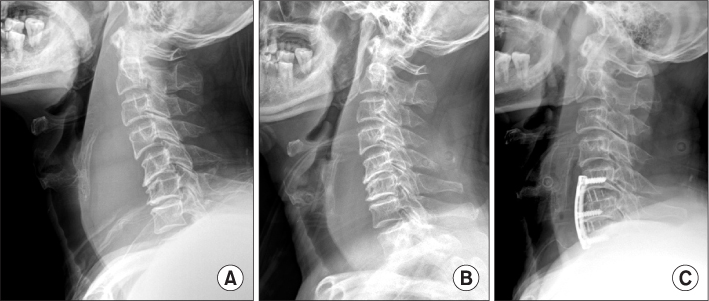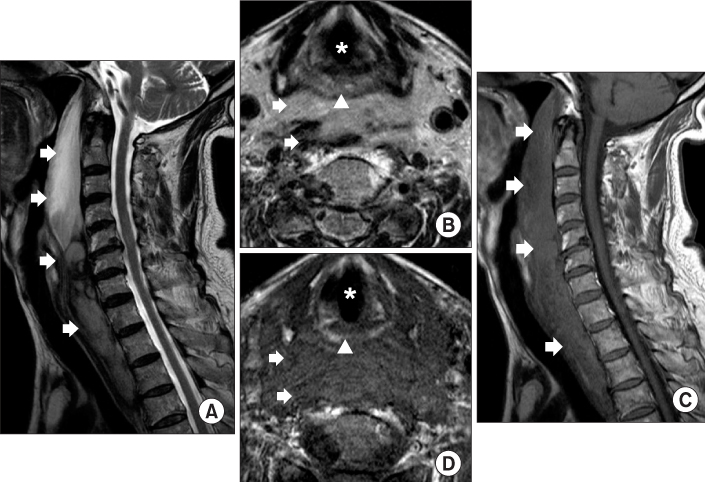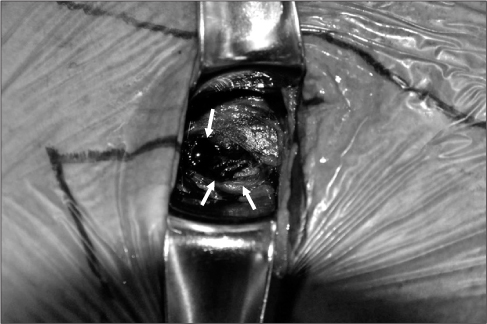J Korean Orthop Assoc.
2012 Jun;47(3):227-231. 10.4055/jkoa.2012.47.3.227.
Airway Compression as a Result of Extensive Prevertebral Hematoma Following Extension Injury of Lower Cervical Spine without Fracture/Dislocation
- Affiliations
-
- 1Department of Orthopedic Surgery, Chonbuk National University Medical School, Chonbuk National University Hospital, Jeonju, Korea. osdr2815@naver.com
- 2Research Institute of Clinical Medicine, Chonbuk National University Hospital, Jeonju, Korea.
- KMID: 2106653
- DOI: http://doi.org/10.4055/jkoa.2012.47.3.227
Abstract
- A 77-year-old man presented with severe dyspnea, neck pain, tingling sensation in both hands, and weakness after an acute prevertebral soft tissue hematoma due to distractive-extension injury. Magnetic resonance images demonstrated an extensive hematoma accumulation, anterior longitudinal ligament and longus colli muscle injuries. We report here a case of dyspnea due to an extensive prevertebral hematoma by soft tissue injury without cervical vertebral fracture and/or dislocation and a review the relevant literature.
MeSH Terms
Figure
Reference
-
1. Emery SE, Smith MD, Bohlman HH. Upper-airway obstruction after multilevel cervical corpectomy for myelopathy. J Bone Joint Surg Am. 1991. 73:544–551.
Article2. Howcroft AJ, Jenkins DH. Potentially fatal asphyxia following a minor injury of the cervical spine. J Bone Joint Surg Br. 1977. 59:93–94.
Article3. Kuhn JE, Graziano GP. Airway compromise as a result of retropharyngeal hematoma following cervical spine injury. J Spinal Disord. 1991. 4:264–269.
Article4. O'Donnell JJ, Birkinshaw R, Harte B. Mechanical airway obstruction secondary to retropharyngeal haematoma. Eur J Emerg Med. 1997. 4:166–168.5. Silberstein M, Tress BM, Hennessy O. Prevertebral swelling in cervical spine injury: identification of ligament injury with magnetic resonance imaging. Clin Radiol. 1992. 46:318–323.
Article6. Fauci AS, Longo DL. Fauci AS, Braunwald E, Kasper DL, editors. Critical care medicine. Harrison's principles of internal medicine. 2008. 17th Edition. New York: The McGraw-Hill Companies;1681–1685.
- Full Text Links
- Actions
-
Cited
- CITED
-
- Close
- Share
- Similar articles
-
- A Case of Delayed Airway Obstruction Associated with Prevertebral Hematoma and Cervical Vertebra Fracture
- Airway Obstruction Caused by Soft Tissue Edema during an Anterior Cervical Approach: A Case Report
- Cervical Prevertebral Hematoma - a Rare Complication of Acupuncture Therapy: A Case Report
- Management of Cervical Spine Injuries without Fracture or Dislocation
- Traumatic Retropharyngeal Hematoma following Cervical Vascular Injury: A Case Report





